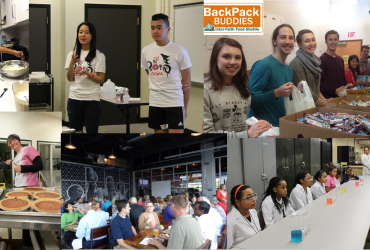By: Matt Teegarden
Popular media today is saturated by sensationalism when it comes to science–especially the science of food. Food scientists and other researchers are rapidly advancing food technology as we race to feed a growing world population, but there is a feeling of discontent among some groups of consumers as these advances are made. Though, apparently this was not always the case. “Historically, the integration of science, technology and food was accepted by consumers. Products such as TV dinners, Tang, frozen foods, packaged food, and other innovations made it possible for the post World War II generations to have food products that met fast-paced consumer lifestyles,” said Jerry Bowman, VP of Communications and Media Relations for IFT. However, in the new age of mass media, we are faced with a unique situation: there is a lot of information put out into the world every day, and, says Jerry, “consumers cannot always discern what is valid scientific communication from reliable sources, or simply the opinion of a self-publisher with no scientific credentials.” He continued:
“The combination of this explosion of information with the rise of the global consumer, food advocacy group efforts, book publishers and general misunderstandings of product and labeling has accelerated the fear factor among the public, even though we have one of the safest food systems here in the United States. The food industry is not the only one facing this challenge. Medical professionals have also faced ongoing consumer education challenges on scientific accuracy, especially when it comes to childhood immunization. As a result, we are now seeing a resurgence of some preventable childhood diseases and much of that is due to fear of science.”
How is it that this fear of science can spread so rapidly? You’ve likely already guessed the culprit. According to Jerry, “the difficult battle for share of mind space is on social media channels, which scientists often don’t frequent.” Tackling this problem is not so easy–social media is always on, and massive numbers of people are contributing to the growing pile of content. The best way to approach it? “We need to communicate in a new way, but we also need to balance that with the fact that food scientists cannot take on this social media discussion alone. It needs to involve multiple individuals and organizations throughout our food system.”
As individuals who have grown up in the age of social media, today’s food science students are increasingly aware of how fast false information can spread. Shaunda Durance-Tod, CanolaInfo Program Manager at the Canola Council of Canada, recently spoke with a group of students about the issue. “We were talking about how much misinformation is out there about food and how it is perpetuated through social media and the internet. Recognizing the problem is one thing but it’s another to figure out how to deal with it.” This exchange led to the creation of a unique program available to IFTSA members and IFT young professionals: The Food Communicators Workshop. “It seemed like a good fit for us to help food scientists early in their careers to get media training so they can help stem the tide of misinformation.”
The power of effective food communication is something that Shaunda is familiar with in her own work. “CanolaInfo launched a campaign last year to help consumers understand what canola is and address some of the myths about canola oil. We specifically addressed the myth that canola is the same as rapeseed and used a multi-faceted approach using digital and traditional media,” she said. They also contacted journalists who had presented incorrect facts about canola, and “many were very receptive to having the right info,” according to Shaunda. Another component of the campaign was outreach to healthcare providers.
Now more than ever, students and young professionals are in a unique position to affect the global food conversation. The Food Communicators Workshop, sponsored by CanolaInfo, is meant to empower students and young professionals to effectively discuss the science of food with consumers and the media. Accepted applicants will receive travel, lodging, and meals as they meet at the IFT headquarters in Chicago, Illinois for this one-day workshop on April 15, 2016. Applications are due February 23, 2016.
The movement to promote accurate and scientifically sound information about food is already underway. Food scientists are starting to be referred to in the media, consumer-friendly information is being produced by IFT, and the future of food is being extensively discussed on FutureFood2050.com (also an IFT initiative). This is our chance, as young food scientists, to learn how we can join in the conversation.






Macs come with iMovie and a lot of Windows machines have Movie Maker. Also, YouTube has some limited video editing and there are free video editing apps for smartphones such as Splice. Here’s more info:
Free video editing software: http://www.digitaltrends.com/computing/best-free-video-editing-software/
Youtube Video Editor: https://support.google.com/youtube/answer/183851?hl=en
Splice: https://itunes.apple.com/us/app/splice-video-editor-free/id409838725?mt=8
Thanks for the resources, Angie! I was just getting stuck on the video editing piece.
S
The same thing has been happening with agriculture – and that sector’s been getting its clock cleaned by billionaire “environmentalists,” fat-wallet Left Coast law firms, the “climate change” crowd that refuses rational debate, and the US government.
Why is so much time being spent on communicating to the public via the media when classic marketing techniques can me used on the product labels to promote scientifically engineered foods? By advertising directly on the product what has been added to it to modify it and how the chemicals work consumers would feel less like they are being deceived by scientists (as it would appear we have nothing to hide about our products).
This would also mean that the consumers will realise that the message of safe engineered food products applies specifically to them- a message on media about a product they may not use will not influence them as much as a clear label on a product they have kept in their cupboards for years.
The best solution may indeed be a combination of both! It is important to communicate through the public via the media because that is also how a lot of misinformation is spread- we just hope that we can spread true science the same way.